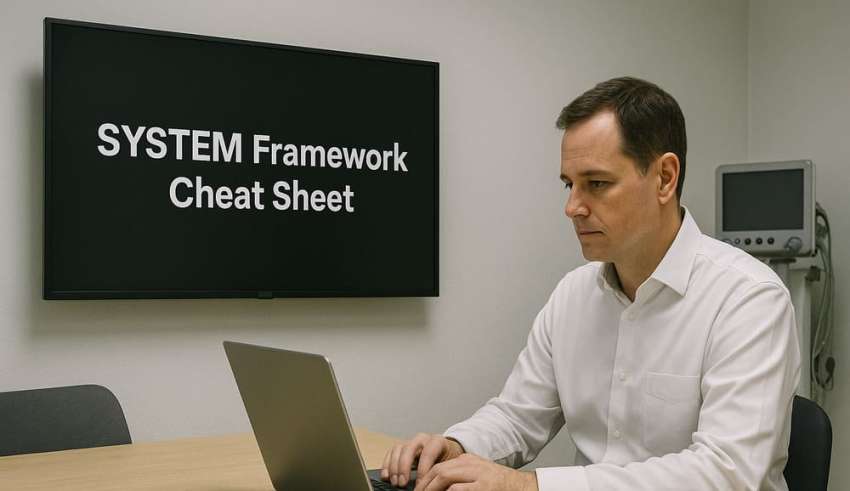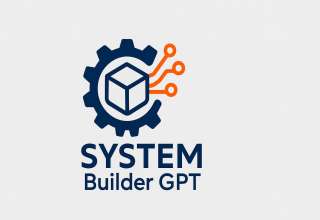
SYSTEM Framework Cheat Sheet
Build Structured, Strategic, and Sustainable Systems
By: Mohamad Haitan Rachman, INOSI
Please use The SYSTEM Builder GPT: https://chatgpt.com/g/g-6857336737c48191baed5baede8b390d-system-builder-gpt
What Is the SYSTEM Framework?
The SYSTEM Framework is a strategic model for planning, developing, managing, and evaluating systems — whether technological, organizational, educational, or operational. It ensures that systems are Structured, Yielding, Strategic, Technology-driven, Empowered, and Managed throughout their lifecycle.
SYSTEM stands for:
- S – Structured
- Y – Yielding
- S – Strategic
- T – Technology
- E – Empowered
- M – Management
Why Use the SYSTEM Framework?
- To guide end-to-end system development or improvement projects.
- To ensure a system is scalable, measurable, and sustainable.
- To align systems with strategic objectives.
- To promote stakeholder empowerment and data-driven management.
- To reduce system failures caused by misalignment, poor planning, or lack of governance.
SYSTEM Framework at a Glance
| Letter | Component | Core Focus | Example Questions |
|---|---|---|---|
| S | Structured | Architecture, workflow, documentation, SOPs | Is the system well-organized and modular? |
| Y | Yielding | Results, performance, KPIs, measurable value | What are the outcomes and how are they measured? |
| S | Strategic | Alignment with long-term goals, adaptability | Does the system support strategic initiatives? |
| T | Technology | Use of digital tools, integration, infrastructure | Are the right technologies used effectively? |
| E | Empowered | People, training, collaboration, user involvement | Are users trained and engaged in system ownership? |
| M | Management | Governance, monitoring, risk control, improvement plans | Is the system governed, evaluated, and well-managed? |
Component Breakdown with Quick Tips
S – Structured
Goal: Design systems with clear architecture, processes, and roles.
Key Actions:
- Build modular architecture (e.g., microservices, layers).
- Define SOPs and WBS (Work Breakdown Structure).
- Document business rules, process flows, and system logic.
- Use clear data models (ERD, UML, flowcharts).
Checklist:
System blueprint and documentation exist.
Functional specs and test plans are available.
Roles and responsibilities are clearly assigned.
Systems are maintainable and scalable.
Y – Yielding
Goal: Ensure the system generates measurable results and impact.
Key Actions:
- Define Key Performance Indicators (KPIs).
- Measure ROI (Return on Investment) and user satisfaction.
- Use dashboards and real-time reports.
- Build feedback loops for continuous improvement.
Checklist:
KPIs linked to each feature or function.
System analytics tools are in place.
Stakeholders can view outcome metrics.
Feedback mechanisms (surveys, reviews) are implemented.
S – Strategic
Goal: Align system purpose with long-term goals of the organization.
Key Actions:
- Map system objectives to strategic initiatives or OKRs.
- Include future scalability in architecture.
- Perform risk and opportunity analysis.
- Integrate system into strategic planning documents.
Checklist:
System objectives linked to business strategy.
Strategic maps or roadmaps are available.
System enhances competitiveness or compliance.
Long-term adaptability is built into the design.
T – Technology
Goal: Leverage appropriate and modern technology effectively.
Key Actions:
- Select platforms, databases, and tools fit for purpose.
- Ensure security, scalability, and reliability.
- Integrate APIs and third-party tools.
- Automate repetitive or error-prone processes.
Checklist:
Tools are modern, supported, and efficient.
Cybersecurity and data protection standards followed.
Technology is aligned with team skill sets.
Automation and integration are utilized where possible.
E – Empowered
Goal: Engage and enable users and stakeholders to own and sustain the system.
Key Actions:
- Involve users in early design phases.
- Provide comprehensive onboarding and training.
- Develop user-friendly interfaces and support.
- Encourage collaboration and innovation culture.
Checklist:
Training materials and user guides available.
System adoption rate is tracked and optimized.
Change champions or user advocates are involved.
Stakeholders feel ownership over the system.
M – Management
Goal: Govern, monitor, evaluate, and improve the system over time.
Key Actions:
- Define system governance structures and roles.
- Implement regular reviews and audits.
- Monitor system health, uptime, and usage logs.
- Update system based on lessons learned and evolving needs.
Checklist:
System owner and administrator are appointed.
Monitoring and logging tools are active.
Lifecycle maintenance plan exists.
Incident response and update workflows are in place.
How to Use This Cheat Sheet
Use this SYSTEM Cheat Sheet as a compass at every phase of the system lifecycle:
| Phase | SYSTEM Elements Emphasized |
|---|---|
| Initiation | Strategic, Structured |
| Planning | Structured, Strategic, Management |
| Design & Architecture | Structured, Technology, Empowered |
| Development | Technology, Structured |
| Testing & Evaluation | Yielding, Management |
| Deployment & Training | Empowered, Technology |
| Monitoring & Feedback | Yielding, Management |
| Continuous Improvement | Strategic, Empowered, Management |
Tips for Analysts, Designers, and Project Leads
- Always start with structure: Clarity avoids chaos.
- Define expected outcomes early and measure progress.
- Make sure every system feature supports a strategic goal.
- Choose technology with intent, not trend.
- Empower your people — they are the real drivers of system success.
- Manage systems as living entities — they grow, change, and need care.
Optional Tools & Templates to Support SYSTEM
| Purpose | Tool/Template |
|---|---|
| System blueprinting | ERD tools (Lucidchart, Draw.io, UML) |
| Documentation | Notion, Confluence, SharePoint |
| Workflow & SOP definition | BPMN tools, Flowchart creators |
| KPI Dashboards | Power BI, Tableau, Google Data Studio |
| Project governance | RACI Matrix, Risk Logs, Change Logs |
| Stakeholder empowerment | User Journey Maps, Training Portals |
| Lifecycle management | DevOps Boards, Jira, Trello, GitHub |
Final Thought
“With the SYSTEM Framework, you’re not just building systems — you’re building the future.”
This cheat sheet is your go-to reference to design smarter systems, solve real problems, and drive meaningful impact. Whether you’re managing a digital transformation, building an enterprise platform, or evaluating an existing process — SYSTEM gives you a clear, strategic roadmap.
If you have questions related to writing, designing, developing, and training systems and wish to collaborate, please contact us at haitan.rachman@inosi.co.id.




